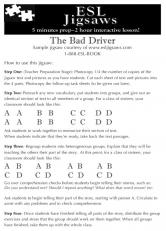ESL Jigsaws
5 Minutes Prep - 2 Hour Interactive Lesson!
Viewing entries tagged with 'free'
Cultural Differences in Gift Giving
One of the most important things we can do as ESL teachers is to help our students crack the cultural code. Gift giving has a lot of unspoken rules which may seem inscrutable to newcomers. Unconvinced? See if you were aware of these cultural attitudes to gift giving in other cultures:
Halloween Noodles
I’ve heard some teachers say that their students were not interested in participating in Halloween. Many others feel that malls are safer locations for children to go trick or treating these days. Here’s a true story of an adult ESL student of mine from Taiwan and her first Halloween here, to illustrate my view that the neighbourhood tradition of trick or treating is a worthwhile one we should teach students about.
Teaching Food at Higher Levels
If you're like me, you like to teach your food unit during the summer when the grocery stores are full of fresh produce and farmers' markets are in full swing.
Garage Sales & Thrift Stores
It's summer and I'm back on the topic of second hand shopping. If you are teaching English to new immigrants, they may see something as they walk around their neighbourhoods at this time of year that they don't have in their home countries: garage sales. Likewise, they will likely come across thrift stores or flea markets in their neighbourhoods.
Writing About Household Repairs
I'm a big fan of using picture dictionaries to teach ESL, particularly to beginner and intermediate levels. Oxford Picture Dictionary, Heinle, Word By Word, I use them all. While they are all excellent and worth purchasing, my favourite is the Oxford Picture Dictionary because the pictures are so clear and pleasing. They also have different levels.
Bargaining Language & Soft Skills
Bargaining (or haggling) takes place all over the world. North Americans often think of it as restricted to places like flea markets or garage sales, when in fact bargaining takes place in a wide variety of business transactions. Think of the negotiation involved in the purchase of expensive items, such as cars or real estate.
Mother's Day
Many teachers who teach English as an additional language are mothers. In the spirit of thanks to mothers everywhere, I'm sharing a couple pages from my low beginner holidays book for free, to use in your class. I hope you find them useful.
Expanding on “Where Do You Live?
“Where do you live?” is one of the personal info questions teachers start with when teaching absolute beginner ESL. Once students have moved past the absolute beginner stage, it’s fun to move beyond that question and get really specific. Where in the world do you live? Where are you now?
Page Directions for Low Beginner ESL
I've created an interactive activity for low beginner ESL to practice page directions. You'll find your class runs smoother when you can draw students' attention to where the class is looking on the page you're working on and make sure everyone is following. You're welcome to download my materials for free to use in your classroom.
Low Beginner Personal Info Game
Anyone who teaches very low beginner ESL knows that you spend a lot of time going over basic personal information questions and answers, often trying to come up with yet another new way to approach the same old material.


